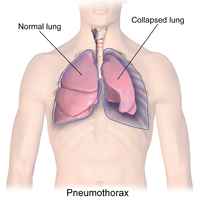
Photo from wikipedia
Background The current study was to investigate the risk factors of occult malignant pleural disease (MPD) detected at thoracotomy and the outcomes of surgical intervention for these non-small cell lung… Click to show full abstract
Background The current study was to investigate the risk factors of occult malignant pleural disease (MPD) detected at thoracotomy and the outcomes of surgical intervention for these non-small cell lung cancer (NSCLC) patients with or without MPD. Methods We reviewed 2,093 consecutive NSCLC patients who underwent thoracotomy from January 2006 to January 2015. We used univariate and multivariate statistics to analyze the associations between clinicopathological variables and occurrence of occult MPD. Survival probability was estimated by the Kaplan-Meier method. Results 5.26% (110/2,093) MPD was observed for these NSCLC patients with 28% of 5-year estimated survival rate. Age ≤50 (P=0.055), high CEA level (P=0.006), advanced N stage (P=0.005), adenocarcinoma (P=0.001) and pleural invasion (P=0.041) were detected to be independent risk factors for the occult MPD. Combination of these five factors, 0.756 of area under curve (AUC) was shown by the integrated prediction model test. Based on the optimal cut-off value (risk score =2.795), low-risk patients have better prognosis than the high-risk patients (median survival time 61.4 months vs. not reached, P<0.001; 5-year survival 71.8% vs. 51.1%, P<0.001). Significantly, 49.0 months/31.7% and 29.4 months/19.5% of the median survival time/5-year survival rate were found for the occult MPD 110 patients receiving primary lesion resection and open-close surgery, respectively (P=0.037). Conclusions We summarized that a new prediction model including 5-risk factors of age, carcinoembryonic antigen (CEA), N stage, adenocarcinoma and pleural invasion was provided to diagnose MPD for the NSCLC patients and primary lesion resection greatly contributed for these MPD patients.
Journal Title: Journal of thoracic disease
Year Published: 2017
Link to full text (if available)
Share on Social Media: Sign Up to like & get
recommendations!